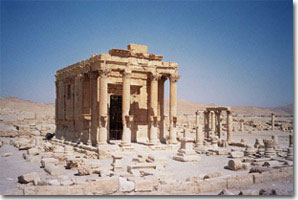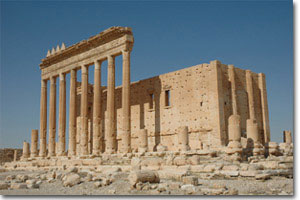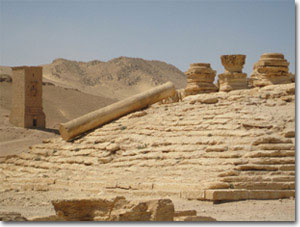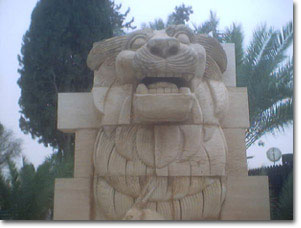|
 In the central Syrian Desert, 235 km north east of Damascus; Palmyra is one of the great sites of the ancient world. The remains of this oasis city seem suspended in time in this harsh desert environment. An elusive and highly romanticized goal of European travelers over the centuries, even today a visit to Palmyra is an experience which alone makes the trip to Syria worthwhile. In the central Syrian Desert, 235 km north east of Damascus; Palmyra is one of the great sites of the ancient world. The remains of this oasis city seem suspended in time in this harsh desert environment. An elusive and highly romanticized goal of European travelers over the centuries, even today a visit to Palmyra is an experience which alone makes the trip to Syria worthwhile.
It was settled as long ago as the end of the 3rd millennium BC and is mentioned in archives of the period from Mari (18th century BC) and as far away as Kultepe (in Cappadocia, modern Turkey). The Semitic name Tadmor is mentioned in Assyrian archives and is listed in the Bible as within Solomon's sphere of influence though the reference is based on a confusion of the name with Tamar in the Judaean desert.
The early Romans found Palmyra an elusive prize. In 41 BC, Anthony attempted to seize its riches but arriving in the oasis found it deserted by its inhabitants and thus devoid of booty. It was probably integrated into Province of Syria by the reign of Nero (54 - 68).
A coalition of Arab interests was formed between Homs and Tadmor to secure a new short-cut across the desert. It was an instant success. Much of the trade between the Mediterranean and the east - India Trans-Oxiana and China - flowed through Palmyra.
At the height of its prosperity in the 2nd century, Palmyra was a center rivaling Antioch, at least in economic importance, perhaps the most active entrepot in the eastern Empire. It was particularly favored by Hadrian during his tour of the eastern provinces in AD 129, being declared by him a free city and renamed Palmyra Hadriana. In 194 the city was transferred to the new province of Syria Phoenice. The city was declared a Roman Colony under Caracalla reign in 212.
The Palmyrene economy suffered from the Sasanian seizure of the territory at the mouth of the Tigris/Euphrates from where Palmyra had previously controlled traffic on the Indian Ocean thus securing the cross-desert caravan trade at its source.
Rome was happy to encourage Odenathus. In 266/7, Odenathus campaigned as far as Ctesiphon on Rome's behalf. That, on the other hand, saved Roman ambitions in the east. Palmyra's ambitions were to assert themselves even more aggressively after the murder of Odenathus in 267/8 during the regency of his wife, Zenobia, on behalf f her son, Vaballath. She asserted Palmyrene power westward, taking Bosra and venturing as far as Egypt in 269-70. Anatolia followed and she began squeezing Antioch from 270. She seemed to enjoy sharing the Roman world with the new Emperor, Aurelian; she would reign in the east, leaving the western Mediterranean provinces to him. It got out of hand for Romans; Aurelian met the mew challenge as a cavalry man. He recovered Anatolia and Antioch and defeated a large Palmyrene force outside Emesa (Homs). Then she went to attack Palmyra. Queen Zenobia attempted to flee eastwards n a dromedary but was captured by the Romans trying to cross the Euphrates. She was taken back to Aurelian camp where she formally surrendered Palmyra to the Emperor. She was later taken to Rome in Sumptuous bondage, when she poisoned herself to avoid humiliation. Then Aurelian went back to Palmyra and made his troops massacre indiscrimination and to sack much of the city. Even the Bel Temple was pillaged, its treasure confiscated.
In the Byzantine period, several churches were constructed in the northern area and the walls further strengthened under Justinian though much of the city was by then in ruins. Khalid Ibn al-Walid took it in 634, but it played only a minor role in the Islamic period later.
A lot of monuments are waiting to be visited in Palmyra:
 * Temple of Baal-Shamin: * Temple of Baal-Shamin:
(lord of the Heavens in the Semitic pantheon responsible for rain and thus fecundity). The first work in the temple dates from the early 1st century AD, and many adjustments has been made since then and kept improving till the 3rd century AD under the rule of Othenadus.
 * Temple of Bel: This stands in an enormous compound (205m by 210m) at the East end of the main colonnaded street. The temple is certainly the most important religious building of the 1st century AD in the Middle East and is one of few to survive. The complex was built in several stages. * Temple of Bel: This stands in an enormous compound (205m by 210m) at the East end of the main colonnaded street. The temple is certainly the most important religious building of the 1st century AD in the Middle East and is one of few to survive. The complex was built in several stages.
* Nabu (Nebo) Temple: Just after the monumental entrance arch of the colonnaded street to the west, the temple of Nabo measures 20m by 3m with bases of the surrounding colonnade, forming a trapezoid. The plan is basically Eastern in inspiration, and the scale is much smaller than that of the Bel temple. Nebo was a Mesopotamian god of wisdom and oracles, equated with the classical god Apollo, which dates the temple to the last quarter of the 1st century Ad, with work continuing on the surrounding complex until the 3rd century.
 * Diocletian's Camp: The camp covers the area face of a funerary temple, commonly called Diocletian's camp (originally constructed in the 2nd century). After about 300m, one can see the remains of another columned avenue leading to the right. This was principal axis of Roman camp constructed by Sosianus Hercules, Governor of Syria under Diocletian (r 284-305). * Diocletian's Camp: The camp covers the area face of a funerary temple, commonly called Diocletian's camp (originally constructed in the 2nd century). After about 300m, one can see the remains of another columned avenue leading to the right. This was principal axis of Roman camp constructed by Sosianus Hercules, Governor of Syria under Diocletian (r 284-305).
* Zenobia Baths: On the right of the colonnaded street, by four monolith columns from Egypt, with red granite jutting from the line of arcading. The baths (which existed for almost a century before being provided with a more sumptuous entry attributed to Emperor Diocletian) have an outline which can be traced in the foundations, including the surviving columns of the atrium style.
 * The Folklore Museum: The Popular Museum of Folklore is located in an Ottoman Khan close to the Bel Temple, with a great many pieces of Palmyra folklore. There one can find a Bedouin tent with carpets made of wool used in decorating the walls and the ground. In addition to that we can clearly see all materials related to the preparation of Arabic coffee, for example the coffee kettle and an Arabic musician's tools called the Mehbaj. Finally, one comes to the hall of the museum, with traditional weaponry used in the past, belonging to many historical ages, but particularly relating to the Islamic age, such as swords and helmets * The Folklore Museum: The Popular Museum of Folklore is located in an Ottoman Khan close to the Bel Temple, with a great many pieces of Palmyra folklore. There one can find a Bedouin tent with carpets made of wool used in decorating the walls and the ground. In addition to that we can clearly see all materials related to the preparation of Arabic coffee, for example the coffee kettle and an Arabic musician's tools called the Mehbaj. Finally, one comes to the hall of the museum, with traditional weaponry used in the past, belonging to many historical ages, but particularly relating to the Islamic age, such as swords and helmets
* The Colonnaded Street: serves as the main axis of the Roman city running 1.2 km approximately north west/south east in its orientation. It holds the monumental arch, an achievement of considerable architectural interest. Just after the arch you'll see Temple of Nebo or Nabu. At the end of the colonnaded street there are the Roman shops and the camp of Diocletian.
* The Theater:
 gave little hint that it was once in the same league as several other major examples in Syria (Apamea, Bosra, Cyrrhus) in terms of size. The theatre dates to the first half of the 2nd century Ad, with the usual facilities for crowd handling and rooms for the actors. The theatre has been restored up to ninth row of seating. The central doorway is set in a half-oval instead of the usual half-circular exedra and there are five doorways leading behind the stage instead of the usual three. gave little hint that it was once in the same league as several other major examples in Syria (Apamea, Bosra, Cyrrhus) in terms of size. The theatre dates to the first half of the 2nd century Ad, with the usual facilities for crowd handling and rooms for the actors. The theatre has been restored up to ninth row of seating. The central doorway is set in a half-oval instead of the usual half-circular exedra and there are five doorways leading behind the stage instead of the usual three.
* The Agora: Located to the west of the theatre, this large rectangular (48m by 71m) enclosure dates from the first part of the 2nd century AD and has been extensively restored since its excavation in 1939-40. The open space was surrounded on four sides by columned porticos, and the walls decorated with windows with richly decorated triangular pediments. The usual statues of local dignitaries are found on the columns and walls (200 in total in this space). The doorway to the Tarrif Court to the east was known as the Senators` gate and was decorated with statues of the family of Emperor Septimus Severus (Emperor 193-211).
* The Tarrif Court: Immediately to the east of the agora is a large courtyard area known as the Tarrif Court in which an inscribed stone was found setting out a decree of 137AD listing the Palmyrene tariff arrangements (now in the Hermitage Museum, St Petersburg). It seems reasonable to deduce that it was here that caravans paid the taxes required under the tariff arrangement. In the South West corner of agora are the remains of a banquet room (triclinium) with benches for reclining guests around the wall.
 * The Tetrapylon: At the end of the Colonnaded Street stood the four of sets of four columns which mark the major crossing point, in an oval place. Reconstructed by the Syrian Antiquities Department from 1939, this comprises a stepped platform on which are the columns, each standing on a plinth and topped by an entablature. Statues originally stood in each of the groupings. The columns were of pink granite from Aswan in Egypt but only one has survived. The modern reconstruction is based on compounded concrete substitutes. * The Tetrapylon: At the end of the Colonnaded Street stood the four of sets of four columns which mark the major crossing point, in an oval place. Reconstructed by the Syrian Antiquities Department from 1939, this comprises a stepped platform on which are the columns, each standing on a plinth and topped by an entablature. Statues originally stood in each of the groupings. The columns were of pink granite from Aswan in Egypt but only one has survived. The modern reconstruction is based on compounded concrete substitutes.
 * Valley of the Tombs: Palmyrene tower tombs are located in a valley that is named after them (valley of tombs), they are in 3 types of the underground chamber "hypogeum", the combination of "hypogeum" and tower and a house or temple tombs (also called tower tombs). The Valley of the Tombs spreads west from Jebel Husseiniye behind Diocletian's camp and stretches 1 km down a barren and forbidding valley. It is an eerie sight at the best of time, even more so under moonlight or at first or last light. There are the underground tombs to the northern slopes of the hill. To the south of Jebel Husseiniye is a group of tower tombs spread out along the edge of the valley. To their east we find Tower Tomb of Kithoth, built * Valley of the Tombs: Palmyrene tower tombs are located in a valley that is named after them (valley of tombs), they are in 3 types of the underground chamber "hypogeum", the combination of "hypogeum" and tower and a house or temple tombs (also called tower tombs). The Valley of the Tombs spreads west from Jebel Husseiniye behind Diocletian's camp and stretches 1 km down a barren and forbidding valley. It is an eerie sight at the best of time, even more so under moonlight or at first or last light. There are the underground tombs to the northern slopes of the hill. To the south of Jebel Husseiniye is a group of tower tombs spread out along the edge of the valley. To their east we find Tower Tomb of Kithoth, built
in AD 40 and standing 10 m high. A relief of a burial feast carved into a niche of the eastern façade is the earliest example found at Palmyra and shows the Parthian rigidity of style later softened by Roman techniques. The most prominent of the tombs along the slopes of Umm al-Belqis, another hill near the Jebel Husseiniye, is the Tower Tomb of Iamliku (Yeliku AD 83), a handsome and imposing family tomb on the right of this grouping. Another group of tower tombs called Tower Tomb f Ellabel and his three brothers.
Qalaat Ibn Maan (Fakhr al-Din al-Maani citadel)
|


